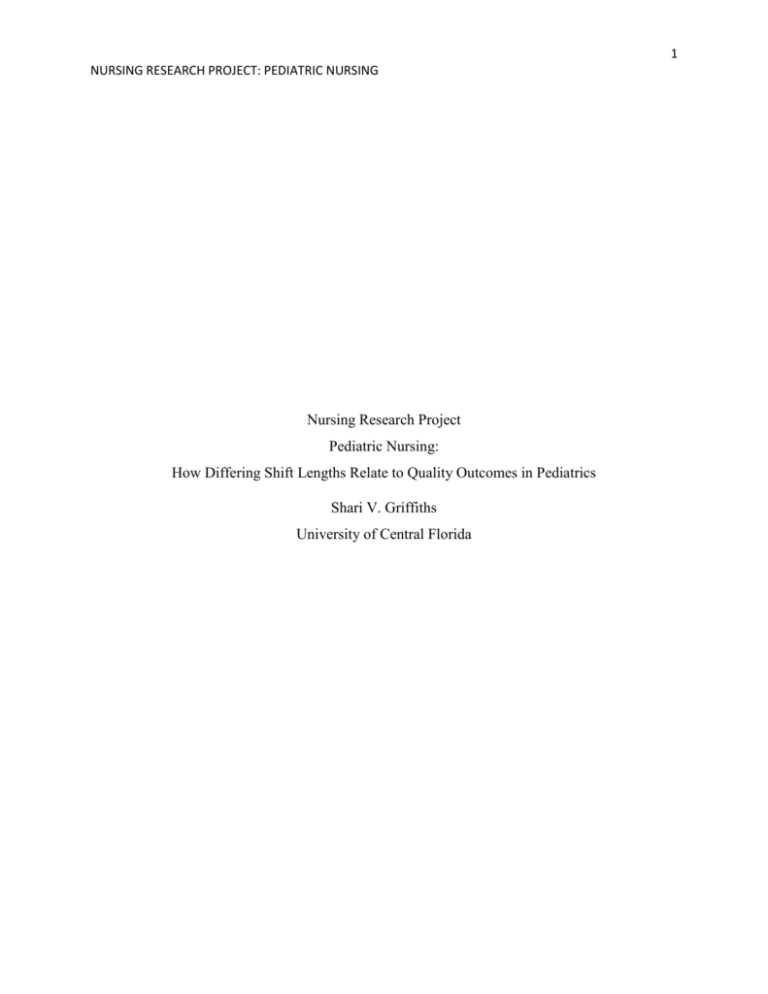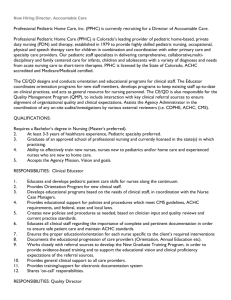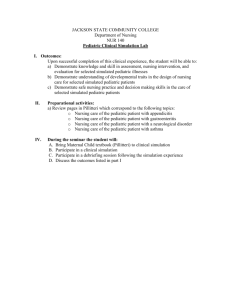File
advertisement

1 NURSING RESEARCH PROJECT: PEDIATRIC NURSING Nursing Research Project Pediatric Nursing: How Differing Shift Lengths Relate to Quality Outcomes in Pediatrics Shari V. Griffiths University of Central Florida 2 NURSING RESEARCH PROJECT: PEDIATRIC NURSING What Specialty Nurse Am I? A Look into Pediatric Nursing: Pediatric nursing is a very special vocation, because it provides the opportunity to play a key role in a child’s life when that child needs you most. Nurses who specialize in pediatrics devote their knowledge and skills to caring for children from infancy through the late teen years and their families. These specialized nurses usually complete advanced training in pediatrics and collaborate closely with physicians and other health care providers who share their dedication to children’s health. Like other nurses, pediatric nurses can perform physical examinations, measure vital statistics, take blood and urine samples and order diagnostic tests. Nurses with advanced training can interpret test results to form diagnoses and develop treatment plans. Pediatric nurses know how to talk to children and how to dispel their fears. They also know how to ask children questions about their health, so they can gather complete and accurate information to aid in diagnosis and treatment. In addition to caring for patients with injuries and illnesses, pediatric nurses spend a significant amount of time educating parents and other caregivers about how to care for their children and protect children’s health. Prevention and health education is a big part of pediatric nursing. Pediatric nurses often staff community health fairs and visit schools to perform physical exams, immunize children, and provide routine developmental health screenings. 3 NURSING RESEARCH PROJECT: PEDIATRIC NURSING Education To become a pediatric nurse, you must first achieve certification as a registered nurse (RN). Earn a Bachelor’s in Nursing at an accredited four-year college, or an associate’s degree or diploma. You must also take classes in early childhood development and consider volunteering or finding part-time work in a child-centered environment, such as a day care center or school. After graduation, you must pass a national licensing exam called the NCLEX-RN to practice as a registered nurse. Once you’re certified, find a job as an RN in the office of a pediatrician or family doctor, or in the pediatric department of a hospital. Take advantage of “in-service” training and other opportunities to learn more about the unique health and developmental needs of children and adolescents. If you want to work with newborns (neonatal care), children who have cancer, children with emotional or developmental disabilities, or children who are critically ill, you may need additional training in those nursing skills, as well. “After you’ve polished and demonstrated your nursing skills, you can pursue specialized training toward a certificate in pediatric nursing. Or, you may choose to earn a Master’s degree in nursing to become a Pediatric Nurse Practitioner (PNP) or a Clinical Nurse Specialist (CNS) in Pediatrics. PNPs are allowed to make diagnoses, prescribe medication and manage care. To become a PNP or CNS, you have to take an exam and meet state certification and continuing education requirements. In addition to nursing knowledge and practical skills, pediatric nurses must have the ability to form rapid connections with their juvenile patients.” Specialty Question: How do longer shifts relate to quality of care in pediatric outcomes? 4 NURSING RESEARCH PROJECT: PEDIATRIC NURSING How Differing Shift Lengths Relate to Quality Outcomes in Pediatrics: Below is an overview of the article and helps in presenting this article as credible. “OBJECTIVE: The aims of this study were to describe the shift lengths of pediatric nurses and to measure the association of shift length with nurse job outcomes, nurse-reported patient outcomes, and nurse-assessed safety and quality of care in hospitals. BACKGROUND: Long work hours have been linked with poor patient outcomes in adult patient populations, but little is known about the relationship in pediatric settings. METHODS: A secondary analysis of cross-sectional nurse survey data was conducted. Our analysis focused on 3710 registered nurses who worked in 342 acute care hospitals that treated children. RESULTS: Most pediatric nurses worked 12-hour shifts, especially in intensive care settings. Nurses who worked extended shifts of more than 13 hours reported worse job outcomes and lower quality and safety for patients compared with nurses who worked 8-hour shifts. CONCLUSIONS: Allocating resources to nursing to improve working hours may be a productive strategy for administrators to improve the health and well-being of pediatric patients and nurses.” “This study is one of the 1st to elucidate the relationships between pediatric nurses’ shift length and nurse and patient outcomes. Twelve-hour shifts are common in pediatrics. Extended shifts (>13 hours) are associated with quality of care concerns. Although longer 5 NURSING RESEARCH PROJECT: PEDIATRIC NURSING shift lengths seem to be preferred by nurses, they may be deleterious for nurses’ and patients’ health. Our results should motivate managers to consider how to prevent shifts of excessive length. Allocating resources to nursing to improve working conditions including achieving safer work hours may be a productive strategy to improve the health and well-being of both pediatric patients and nurses. Results indicate that nurses who worked the longest shifts had increased likelihood of burnout, job dissatisfaction, and intent to leave their jobs compared with nurses who worked 8-hour shifts.” ( Stimpfel et.al.2010) My article is research article because it is a scholarly article. It was obtained from the UCF library database MEDLINE, it is a peer reviewed article and includes the following things: List of the author(s) and their credentials. (excerpt from site): “Author Information Author Affiliations: Research Fellow (Dr Witkoski Stimpfel), Jessie M. Scott Endowed Term Associate Professor in Nursing and Health Policy, Associate Professor of Sociology, and Associate Director (Dr Lake); and The Claire M. Fagin Leadership Professor of Nursing and Director (Dr Aiken), Center for Health Outcomes and Policy Research, University of Pennsylvania, Philadelphia; Assistant Vice President, Nursing Research and Evidence-Based Practice, Education, and Outcomes (Dr Barton), The Children’s Hospital of Philadelphia, Pennsylvania; and Executive Vice President (Ms Gorman), Children’s National Medical Center, Washington, DC. Funding source: Grants to the Center for Health Outcomes and Policy Research from the National Institute of Nursing Research (T32-NR-007104 and R01-NR-004513, L. Aiken, PI) and from the Children’s Hospital of Philadelphia. The authors declare no conflict of interest. Correspondence: Dr Witkoski Stimpfel, Center for Health Outcomes and Policy Research, University of Pennsylvania, Claire M. Fagin Hall, Room 388R, 418 Curie Boulevard, Philadelphia, PA 19104 (amywit@nursing.upenn.edu). 6 NURSING RESEARCH PROJECT: PEDIATRIC NURSING Supplemental digital content is available for this article. Direct URL citations appear in the printed text and are provided in the HTML and PDF versions of this article on the journal’s Web site (www.jonajournal.com).” This shows the authors credibility though schooling, research, advancement in this field of study, and credentials / certifications. Outlines all bases of the study with proper documentation. Has been peer-reviewed. List all sources and where to find them. List authors affiliations and sponsors. Has all information clearly posted and updated. Has proper formatting , and free of grammatical errors Up to date information. The research provided can be applied in any setting not just a pediatric setting. Although it may seem easier or better financially nurses need to keep their hours at a minimum (less than 12 hours), because this will overall lead to nursing satisfaction, less errors due to fatigue, sluggishness, restlessness etc. and better patient outcomes. The nurse will be more engaged with their patient, have a clear mind to better problem solve, more focused on minute details that might have been overlooked if overworked, and have a better attitude while at work. If you’re cranky it will affect your work ethics; especially dealing in pediatrics it’s extremely important to keep that joyful attitude. Children feed off of our emotions and their families need the support, if the nurse isn’t at his/her best it will definitely 7 NURSING RESEARCH PROJECT: PEDIATRIC NURSING affect their behavior and quality of care. Conclusion This information definitely applies to the nursing body of knowledge. It is specific to nursing hours and correlates to pediatric patient outcomes. We as nurses/ nursing students will be the same nurses treating the young; we need to realize the importance of our health and rest in order to provide this vital care. If the length of our shifts are causing a decrease in our care it should absolutely be brought to a higher authority to ensure the wellbeing of our helpless patients and our wellbeing. When looking at job satisfaction and pediatric patient morbidity this is something that should be analyzed and updated in hospitals.” To provide the safest and highest quality of care, nurses need to be alert to changes in patient status, process information quickly, and intervene in a timely fashion. Shift work, overtime, and associated stress can lead to sleep deprivation or poor sleep quality. Sleep loss causes not only cognitive and behavioral impairments but physiological and emotional difficulties as well. Overtime and extended shifts among nursing staff have been associated with poor patient outcomes and errors in adult population.”( Stimpfel et.al.2010) This is something that managers and staffing personnel need to be especially keen to because if they aren’t aware or their staffing ratio/ shifts, and the nurse isn’t proactive in the intervention it could cause a downhill spiral. 8 NURSING RESEARCH PROJECT: PEDIATRIC NURSING References Institute of Medicine. To Err Is Human: Building a Safer Health System. Washington, DC: National Academy Press; 1999 King S. Josie’s Story: A Mother’s Inspiring Crusade to Make Medical Care Safe. New York, NY: Atlantic Monthly Press; 2009. Stimpfel, Amy Witkoski PhD, RN; Lake, Eileen T. PhD, RN, FAAN; Barton, Sharon PhD, PCNS-BC; Gorman, Kathleen Chavanu MSN, RN, NEA-BC; Aiken, Linda H. PhD, RN, FAAN. How Differing Shift Lengths Relate to Quality Outcomes in Pediatrics. www.jonajournal.com; 2012.







